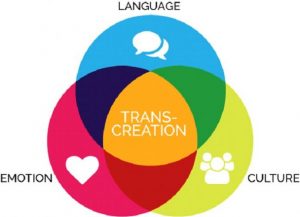Transcreation: Definition and How It Differs from Translation
By Sarah-Claire Jordan
 With all of the advances in technology, social media, and business practices, it can be hard to keep track of all of the new terms and concepts that are born every day. Translation has been around for a while now, and localization seems to have caught on pretty well, but transcreation is something that not a lot of people know about. It may sound weird and foreign, but it doesn’t have to, and once you understand it you can use it to your advantage.
With all of the advances in technology, social media, and business practices, it can be hard to keep track of all of the new terms and concepts that are born every day. Translation has been around for a while now, and localization seems to have caught on pretty well, but transcreation is something that not a lot of people know about. It may sound weird and foreign, but it doesn’t have to, and once you understand it you can use it to your advantage.
It is, simply put, translation to the nth power. It is translating, while localizing at the same time, with a bit of extra care put into it. It is translating the words that need to be translated into the target language, while keeping in mind all of the nuances and peculiarities of the culture the target language is spoken in. Though it may not seem that much different from translation, it truly is different, and in many ways.
For starters, transcreation specialists tend to be writers first, and translators second. Many people who are copywriters in one language will go into this work and create transcreated content in their native language. The fact that writers are more important for this shows that it is much more about cultural differences and style than regular old translation is.
Projects generally start differently from translation projects. With a translation project, all that needs to be done is for the source text to be provided, and maybe a few guidelines in terms of format and style. For a transcreation project, everything starts of with a creative briefing, just as any other creative project would be started. The concept of the project is discussed, as well as cultural and linguistic factors. This is a much more involved process than what is done for translation projects.
Something else that separates translation from this creative process is the fact that the look and feel of the final product is more important than it is for a translation project. The format, pictures, and even colors used in the final product need to not only coincide with the target culture, but also make a good impact on the target audience. Some colors, format, and even images don’t work in some cultures, and can even be offensive. Knowledge of these things keeps unhappy accidents from happening.
Finally, it results in all new messages. The original message that the project may have started out with is not usually one that the target audience will be able to understand or even relate to, so that is where specialists come in and use their expertise to translate as well as create something new. The best way to explain this is to use the example of a marketing campaign that worked well in one country but now needs to be changed to be used in another. The basic concept remains, but even that might need adjusting so that it makes more sense to the people it is meant for. This is basically what transcreation is all about.
Category: Business Translation








